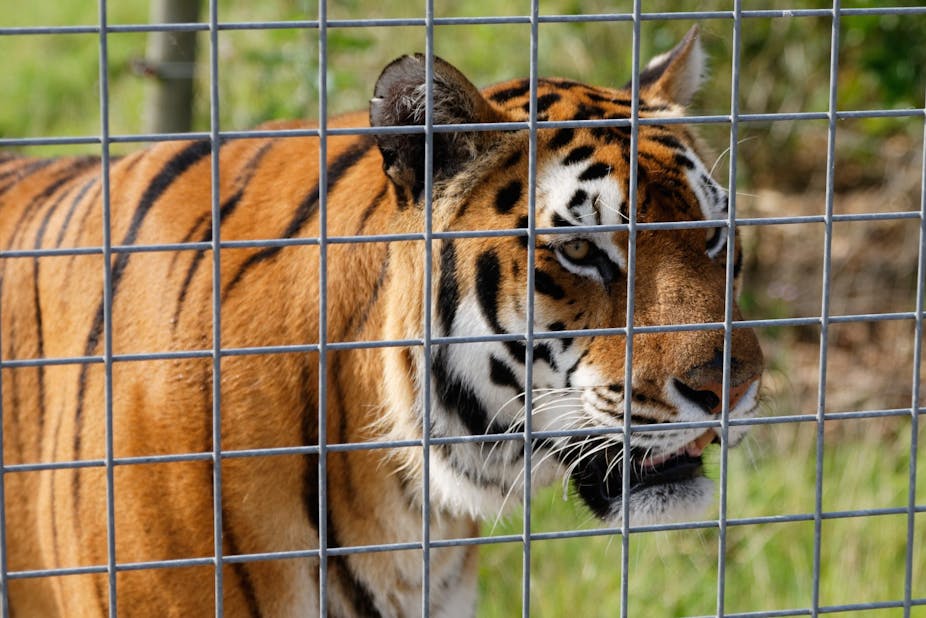A big cat is apparently lurking in the countryside near Disneyland, Paris. After reports of a tiger on the loose, 200 police and military officers backed up by a helicopter, and a special “wolfcatcher”, were called in to look for the animal. Local authorities have now confirmed the mystery creature is not actually a tiger.
The tiger story was always unlikely. Local zoos and a passing circus have denied knowledge of any animal escapes and the photograph of the “tiger” was unconvincing, typical of such sightings: low light level, on the brow of a hill and no scalable objects within view.
The animal does appear to be a cat, but the person who reported it did not report a tiger but a lynx. Could this be a case of media exaggeration? After all lynx are native to France and not a threat to humans, whereas tigers… If it is a lynx and a wild one then this in itself is newsworthy as this species is only, normally, to be found a few hundred kilometres from Paris.

If it proves to be a more exotic big cat then its origins are of great interest. It could be a “pet” from a private collection. Although, I suspect just as in the UK few people in France are able to meet the legal requirements for maintaining such animals in captivity. In the UK up until 1976 it was possible to keep animals such as tigers in your back garden, but the Dangerous Wild Animals Act put a stop to this.
Elusive escapees?
Since the 1950s there have been reports of big cats on the loose in the UK, a country where badgers count as big and scary. In the 1990s the fabled “Beast of Bodmin Moor” regularly made headlines. And over the years a number of cats such as pumas and lynx have been captured in the UK.
But these animals usually show signs that they were escapees from captivity. Scientific evidence supporting big cats living wild in the UK has not really been forthcoming. Most evidence is photographic and suffers from the same problems as the “Paris tiger” image.
Big cats can leave footprints, pugmarks, but they are most likely to be left when the ground is soft, after rain, and this can distort their size as the cat sinks into the mud. One of the problems with big cats in the UK is that it tends to be investigated by amateurs who want to find a big cat and so their objectivity can be questioned.
A supposed photograph of the Paris tiger’s pugmark is clearly that of a dog: you can see the claws at the end of the toes. All cats aside from cheetahs retract their claws when walking – something dogs cannot do.
Escapes are rare
I worked at the Edinburgh Zoo for four years back in the mid 1990s and we never had an animal escape of any significance. By this I mean nothing dangerous. We did have a few animals go over the wall for a few minutes, but they always returned of their own accord.
The most memorable incident involved a group of cotton-top tamarins. These tiny monkeys could go where they wished within the zoo and one day they decided to visit a neighbouring hospital. We know this because the hospital rang the zoo saying that one of their patients, who was taking strong pain killing medication, complained that he had seen gremlins at his bedroom window.

Zoo animal escapes are rarer than we think. We need to remember that there are around 10,000 zoos in the world housing about 4m animals and crucially the escape of a zoo animal is big news, especially if it is dangerous. We live in a world of near misses. Think about crossing the road: everyday cars miss us by seconds but when one hits someone it becomes news. It is thus that we perceive roads as dangerous and clearly if we crossed them without due care and attention they are dangerous. Zoos build their animal enclosures with care and attention to avoid animal escapes.
Of course there have been cases where zoo animals have escaped and injured or killed people such as in the San Francisco Zoo where a tiger killed a visitor and attacked two others in 2007. An investigation into the case implicated those attacked in provoking the escape. There has even been a case where a wild tiger entered Nandankana zoo in India to mate with the resident tigress. Thus, we cannot assume animals escape because they don’t like their home.
At the Belo Horizonte Zoo in Brazil a female tamandua, a tree-living anteater, used to escape her enclosure into the surrounding wild habitat to find a mate and get pregnant. Then she would return to the zoo to have her baby with all of the creature comforts that a zoo provides. She did this several times.
I for one will be surprised if the cat near Paris turns out to be a tiger: as a conservation biologist I will be delighted if it proves to be a wild lynx but unsurprised if it turns out to be a domestic cat.

